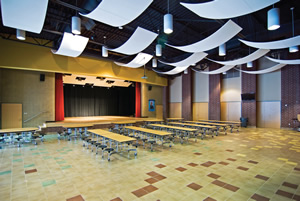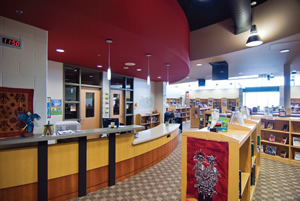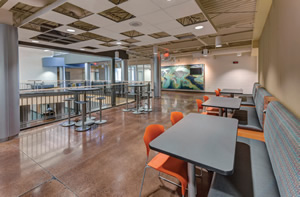Controlling Noise and Increasing the Voice

PHOTO COURTESY OF ACOUSTICS BY DESIGN
In the beginning, there were no unified criteria or standards for education acoustics. And, while acoustical consultants were retained for performing arts centers, gymnasiums, and similar types of facilities, little attention was paid to acoustics in the typical classroom.
Then, a parent of a student who was hard of hearing petitioned the ADA on the basis of equal access to learning, indicates Kenric Van Wyk, PE, INCE Bdcert, LEED-AP BD+C, president of Acoustics by Design, a Grand Rapids, Mich.-based acoustic consulting group. “This led to a movement within the community to gather standards that could be used for core learning environments,” he says. “Its focus was primarily the standard classroom, but extended to media centers, laboratories and any place where learning happens.”
The movement’s torchbearers were Louis Sutherland and David Lubman, says Van Wyk, who is also president of the Council of National Acoustical Consultants (NCAC), an international organization committed to supporting the acoustical profession. And, in 2002, ANSI S12.60-2002, “Acoustical Performance Criteria, Design Requirements and Guidelines for Schools,” was released. “It primarily limits reverberation time and non-occupied noise levels,” notes Sooch SanSouci, senior consultant with Philadelphia-based Metropolitan Acoustics, which specializes in acoustic and A/V design.
Specifically, it covers three things, Van Wyk says. The first is reverberation time (how much sound absorbing treatment there is in a space). “It’s common to have sound absorption tile on ceilings and carpet,” he says. “Today, many facilities are designed with open ceilings, especially in laboratory-type environments, shop rooms and art rooms, and it covers the design of those spaces as well.” The second is noise isolation. “This is the separation from classroom to classroom, with the intention to bring down background noise levels so there’s no interference of speech communication,” he says. The third is background noise caused by mechanical systems. “This was contentious because many classrooms were designed with unit ventilators, which are inexpensive and so are frequently used, but which also tend to be loud,” he says. “To meet the new guidelines, designers had to choose centralized mechanical systems with air distribution systems.”
As of today, the standard is now best practice for acoustics design in classrooms and, says Van Wyk, LEED has adopted portions of it for education guidelines.
A summary of the standard can be found at the acoustics.com website: www.acoustics.com/ansi_education.asp. Acoustics.com is an alliance of educators, experts and design professionals dedicated to promoting the importance of acoustics in the architecture, design, construction and building communities, as well as to the general public.
The complete standard is available online from the Acoustical Society of America (ASA): www.asastore.aip.org. ASA is a premier international scientific society in acoustics, dedicated to increasing and diffusing the knowledge of acoustics and its practical applications.
SanSouci has been researching classroom acoustics since 1995. “When ANSI S12.60 came along in 2002,” he recalls, “we all agreed it was better than nothing, even though we thought it was weak.”

PHOTO COURTESY OF METROPOLITAN ACOUSTICS
The point is
The question, SanSouci notes, is how to increase the speech level and decrease the noise level so students in the back of the room have a fair chance of hearing what’s being said. “What we’ve concluded in our research through the years,” he says, “is that some of the things we thought were best to do with walls and ceilings to help with speech intelligibility were actually detrimental and even, in some cases, decreased it.
“What we’re tying to do in the future,” SanSouci continues, “is find ways to control noise first and increase the level of the voice to every seat second. A few wall treatments in a few places can be really beneficial. Arcs can be beneficial. For example, in 2003, we tried a technique using reflective arcs on walls and the ceiling, with the result being that speech was seven decibels louder in the back of the room than without it. However, a flat, hard ceiling increases noise, so that’s to be avoided.”
With this history and experience in mind, Van Wyk and SanSouci, offer their insights and wisdom regarding classroom acoustics, especially as it relates to walls and ceilings.
Acoustic fundamentals
Acoustics inform access memory. “If you hear it and forget it, it’s as though you didn’t hear it,” SanSouci explains. “So, in classrooms, it’s important that students don’t become tired trying to listen through the noise. When they get tired, they stop listening and, when they stop listening, they stop learning.
“The metric that is preferred today for classroom design is ‘speech-to-noise ratio (SNR),’” SanSouci continues. “We try to provide +15 dB at every seat, which is excellent. In addition, +10 dB to +14 dB can be regarded as good, and +4 dB to +9 dB is fair. Below +3 dB guarantees that students will not remember everything, commonly less than 50 percent of what was said.”
Another acoustic theme that acousticians are concerned with is sound reflectivity. Surprisingly, many products that promote themselves as offering sound absorption really only offer reverberation reduction, SanSouci notes. They do not effectively control noise and, more over, can increase the noise level in small rooms (less than 1,600 sq. ft.). This is because they have a high sound reflectivity value. “Administrators can recognize this concept if they have ever had a meal in a noisy restaurant,” he explains. “Surfaces with high sound reflectivity increase the background sound level, and people tend to speak 12 dB louder than the background sound level (Lombard reflex), thus raising the perceived sound level for the neighboring table.”
Also regarding fundamentals, American Speech-Language-Hearing Association (ASHA) (www.asha.org) endorses the ANSI S12.60-2002 standard and recommends the following criteria for classroom acoustics:
- unoccupied classroom levels must not exceed 35 dBA,
- the signal-to-noise ratio (the difference between the teacher’s voice and the background noise) should be at least +15 dB at the child’s ears, and
- unoccupied classroom reverberation must not surpass 0.6 seconds in smaller classrooms or 0.7 seconds in larger rooms.
Design fundamentals
Designing correctly for acoustics doesn’t cost any more than designing poorly, plus it saves time and money from correcting errors later, so it should be done correctly from the outset.

PHOTO COURTESY OF ACOUSTICS BY DESIGN
“In addition,” Van Wyk observes, “corrections probably aren’t done very often because, by the time construction is done, there’s no money left for repairs, so the mistakes stay for the life of the building. The cost of making the repair is likely to be three to four times the cost of doing it right the first time. That’s throwing good money after bad, if you will.”
Interestingly, a number of design elements are related to adjacencies, such as placing mechanical rooms next to service corridors rather than next to classrooms. “These considerations don’t cost more in the design process, they simply require awareness,” says Van Wyk.
To ensure design is done correctly, hire an acoustical consultant at the beginning of the project to ensure that the correct design elements are incorporated from the beginning. “When consultants are involved early, they can bring issues to light and help mold the design as it moves forward,” Van Wyk explains.
For example, regarding how furniture affects classroom acoustics, there is a movement toward group learning environments where students are seated six to a table, which has a media device at one end, and with five or six tables in the classroom. The students are all talking and sharing, so the noise level increases. “In this environment,” says Van Wyk, “it’s really important for there to be a good acoustical treatment so students can hear the information presented at a lower volume. Without it, you get a cocktail party effect in that, when two couples are in the room, we can comfortably stand five feet away and hear each other in a normal voice. However, as more couples join the party, the noise level increases, people move closer and talk louder to successfully communicate.” The question is how to incorporate good acoustics. It could be via the ceiling or via the furniture. It could be that the end of the table that features the media device incorporates acoustical treatment for sound absorption.
Ceiling tile specifics
Not surprisingly, ceiling tiles are a strong beginning point for classroom acoustics. Choose an acoustical absorptive ceiling with a Noise Reduction Coefficient (NRC) of at least 0.7. NRC refers to how much absorption the tile has: At 0.7, it absorbs 70 percent and reflects 30 percent. “The biggest problem we see are spaces designed with open ceiling environments, which can be acoustically poor,” says Van Wyk. “These spaces require acoustic absorption, such as wall panels, but it is difficult to get enough panels in.”

PHOTO COURTESY OF ACOUSTICS BY DESIGN
Note, too, that there are acoustic ceiling tiles that are inexpensive and work wonderfully; and there are acoustic ceiling tiles that are expensive but only work modestly. “Therefore,” says SanSouci, “you can’t use price as a metric for acoustics.”
SanSouci adds that, while absorptive ceiling tiles are just a good start to successful classroom acoustics. “We have found that, if you use good absorption at ear level all the way around the classroom, you reduce the perception of the noise level,” he says. “Students believe the noise level is louder than it actually is, so they conduct themselves more quietly. There can be as much as eight decibels difference in self noise between an optimized environment and a normal environment. If we want speech to be loud enough to hear and noise low, that’s one option for all ages and hearing abilities.”
“There are changes are underway in classroom acoustics,” San- Souci concludes. “Surely, some of this seems complicated — more complicated than expected. But someday, students will be able to learn much more in less time because they are able to hear what is being taught.”
TED TELLS IT
To take classroom acoustics a step farther, SanSouci recommends a TED talk that discusses today’s classroom dilemma of standardized learning for all when, truth be told, everyone has different needs: www.ted.com.
This article originally appeared in the issue of .